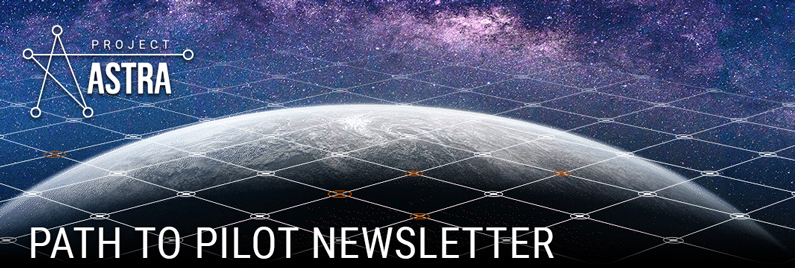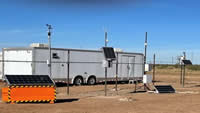
VOLUME 1, ISSUE 1: JULY 2021
| Welcome to the first issue of the newsletter for Project Astra. Project Astra will establish a pilot sensor network that will leverage advances in methane-sensing technologies, data sharing, and data analytics to provide near continuous methane monitoring for a region encompassing approximately 50 km2 in the Permian Basin of West Texas. The project has three phases: sensor testing, digital simulation and design of the network, and a pilot deployment. |
The Project Astra partnership, led by The University of Texas at Austin, initially brought together the Environmental Defense Fund, ExxonMobil, GTI, and Pioneer Natural Resources Company to develop the network. As described in this newsletter, Chevron, Microsoft, and Schlumberger have now joined the partnership, and AT&T and the Collaboratory to Advance Methane Science have funded parts of the sensor testing and digital simulation and design. |
 |
Methane Sensor Inter-comparison Completed Seven promising new methane sensor technologies were deployed and field-tested in The West Texas Methane Showdown, a pilot program that was launched in October 2020 and was completed in June 2021. READ MORE > |
| Chevron, Microsoft, and Schlumberger Sign Memorandum of Understanding Three new companies join original partners EDF, ExxonMobil, GTI, Pioneer Natural Resources, and the University of Texas. |
 |
|
Methane Sensor Inter-comparison Near Completion
 |
Seven promising new methane sensor technologies have been deployed in West Texas' Permian Basin. This sensor deployment and field-testing pilot program, which is known as the West Texas Methane Showdown, is the next phase of Project Astra and is supported by Environmental Defense Fund, ExxonMobil, Pioneer Natural Resources, AT&T and the Collaboratory to Advance Methane Science (CAMS).
The sensors operated continuously since October 2020, on a site near Midland operated by a Project Astra participant. The sensors are using a variety of techniques to detect changes in methane concentrations, with some able to detect shifts as small as 0.1% of the concentration of methane. The self-powered sensors communicate measurements through cellular networks, and operated through June 2021.
"Defining the capabilities of sensors that can operate unattended in harsh environments is a first step in transforming the way that methane emissions are monitored," said David Allen, lead investigator on the project, Director of UT Austin's Center for Energy and Environmental Resources and a professor in the McKetta Department of Chemical Engineering. "Cost-effective, high-frequency monitoring for methane emissions requires innovative technologies. The companies that are deploying their sensors are at the forefront of methane sensing."
After the Texas Methane Showdown has gathered data from its sensors for nine months, the best-performing sensors will then be considered for use in a prototype next-generation monitoring network scheduled to launch in late 2021 in a roughly 50-square-kilometer region in the Permian Basin.
The companies working with Project Astra and participating in the development of the new sensors range from small startups with only a handful of employees to large companies that market a wide range of tech products. Participants include Aeris Sensors, Project Canary, Eco-esolutions, Quanta3, Scientific Aviation, Teledyne and Troposphere. The findings and analyses of the West Texas Methane Showdown and the subsequent prototype network will be released after sampling ends in June. A technical report will be made available at that time and a public webinar will describe the findings. The testing will provide guidance on how companies, states and the federal government measure, monitor and manage methane emissions in the future.
All details regarding project support can be found on the Project Astra University of Texas-Austin Technical Site under Sponsors at http://dept.ceer.utexas.edu/ceer/astra.
Complete details on the sensors are also available on the website at https://dept.ceer.utexas.edu/ceer/astra/showdown/showdown.cfm
Chevron, Microsoft, and Schlumberger Officially Join Project Astra Team
Chevron, Microsoft, and Schlumberger have signed on to Project Astra, joining The University of Texas at Austin, the Environmental Defense Fund, ExxonMobil, GTI, and Pioneer Natural Resources Company in a coordinated effort to demonstrate a novel approach to measuring methane emissions from oil and gas production sites.
Project Astra, which boasts a first-of-its-kind high-frequency smart monitoring system, aims to transform the way methane emissions are detected and provide an affordable, efficient solution to help reduce methane emissions that contribute to climate warming.
"The U.S. EPA reports that over the next 20-year period, methane emissions will have an 83x greater greenhouse gas warming potential compared to carbon dioxide," said Darryl Willis, corporate vice president for Energy Microsoft. "As this remains a critical threat to our environment, digital transformation will be crucial to reduce the global pollution of methane emissions. That's why Microsoft is pleased to join Project Astra as a trusted technology partner and supply the software needed to deploy IoT methane sensor networks at a global scale."
Project Astra represents an entirely new approach that will test the technical, operational and environmental potential of an automated network of methane sensors. Once operational, this kind of smart digital network would allow producers and regulators to pinpoint methane releases for mitigation and offer the ability to easily increase the frequency of measuring.
"This project has incredible potential for opening new pathways to find and reduce methane emissions from the more than 1 million existing oil and gas wells in the United States," said David Allen, lead investigator on the project, professor of chemical engineering at UT Austin and the director of the Cockrell School of Engineering's Center for Energy and Environmental Resources.
"Project Astra is testing a disruptive concept that can scale continuous monitoring to the entire industry, and it requires contributions from many different organizations. Our new partners are pioneering and highly respected organizations that share our focus on technology innovation, and we're excited to have them join this effort and help expand its impact."
Collaboration is critically important in improving methane management. Cost-effective monitoring for methane emissions requires the right team of partners to speed and scale deployment to make the interconnected sensor network widely available.
"Longstanding partnerships with academia, technology companies, industry, and NGOs have led to great advances in emissions reduction technology in the U.S.," said Nicole Barber, corporate affairs manager for Chevron's Mid-Continent Business Unit. "We are pleased to begin working with the Project Astra partners to advance the development and testing of new tools that will produce high-quality, actionable data that will further aid the industry's ability to reduce emissions."
"Reducing methane emissions is an imperative for our entire industry," said Kahlina Abdeli-Galinier, Emissions Management Business Director for Schlumberger. "The concept developed under Project Astra leverages collaboration and innovation across the industry to reduce methane emissions in ways that could be uniquely effective and efficient. Our goal at Schlumberger is to help turn that concept into reality for the industry."
Collaboratory to Advance Methane Science to Fund Development of Pilot Region Digital Twins
 |
The Project Astra network will be designed using a digital simulation of the pilot region. The development of digital simulations, or digital twins, starts with estimates of both normal and abnormal emissions from oil and gas operations. The emission estimates are based on the Methane Emission Estimation Tool (MEET), developed with support from the Collaboratory to Advance Methane Science (CAMS). MEET allows researchers at the University of Texas to estimate emissions, minute by minute, from each of the hundreds of sites in the Project Astra pilot region. Details of MEET are available from CAMS. These emissions are then linked to atmospheric dispersion models, which estimate methane concentrations throughout the Project Astra region, minute by minute, at a spatial resolution of 100 m.
To demonstrate the construction of digital twins, the Project Astra team at the University of Texas has developed a prototype that simulates methane concentrations in a 10 km2 region in the Permian Basin. The prototype digital twin has been used to evaluate dispersion models and meteorological data sets, and has been used to assess how many methane sensors will be required to detect unintended methane emissions. A video (194MB PPT download) showcasing the preliminary results, now posted on the Project Astra web site, describes how a relatively small number of sensors can detect unintended emissions in the range of 1-10 kg/hr.
A new effort at the University of Texas at Austin, to be funded by CAMS, will apply the methods demonstrated in the digital twin prototype to the entire Project Astra pilot region. Emission modeling, using MEET, will be coupled with atmospheric models to estimate the spatial and temporal patterns of methane emissions. This digital twin will predict concentrations in the Project Astra pilot test region, minute by minute, caused by normal and abnormal emissions. The simulations will be run for periods of weeks to a year, and will predict concentrations every 100 meters. The data will be used to select strategic sites in the Project Astra pilot region for deploying sensors, identifying the types and locations of sensors that will quickly and reliably detect abnormal emissions, at the lowest cost.
The digital twins will also be used to test data analytics. Once deployed, the data from the sensor network will be tested for its ability to detect and determine the location of abnormal emissions. This effort will evaluate the effectiveness of anomaly detection systems before they are deployed. "Determining where and how many sensors should be deployed is critical to designing cost-effective methane monitoring systems," said David Allen, lead investigator on the project, director of UT Austin's Center for Energy and Environmental Resources and a professor in the McKetta Department of Chemical Engineering. "The characterizations of sensor performance being collected in the Permian Basin, and the design capabilities provided by the digital twin, provide us with the building blocks for sensor network design."
All details regarding project support can be found on the Project Astra University of Texas-Austin Technical Site under Sponsors at http://dept.ceer.utexas.edu/ceer/astra.


